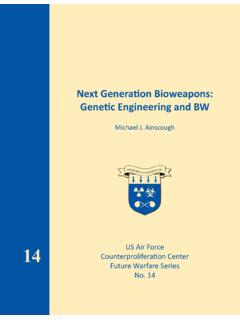Transcription of DNA: The Genetic Material
1 DNA: The Genetic MaterialChapter 102 DNA as the Genetic Material DNA was first extracted from nuclei in 1870 named nuclein after their source. Chemical analysis determined that DNA was a weak acid rich in phosphorous. Its name provides a lot of information about DNA: deoxyribose nucleic acid: it contains a sugar moiety (deoxyribose), it is weakly acidic, and is found in the nucleus. Because of its: nuclear localization subsequent identification as a component of chromosomes it was implicated as a carrier of Genetic genes composed of DNA or protein? Chromosomes are also known to contain protein so early on it was a challenge to demonstrate that DNA was indeedthe molecule that contained the Genetic information . DNA Only four different subunits make up DNA Chromosomes contain less DNA than protein by weight Protein 20 different subunits greater potential variety ofcombinations Chromosomes contain more protein than DNA by weight Classical experimental data confirmed DNA as the transformation implicatesDNA as the substance of genes 1928 Frederick Griffith experiments withsmooth (S), virulent strain Streptococcuspneumoniae, and rough (R), nonvirulent strain Bacterial transformation demonstrates transfer ofgenetic Material 1944 Oswald Avery, Colin MacLeod, andMacIyn McCarty determined that DNA is the transformationmaterial5 Griffith experiment:transformation of bacteriaFig.
2 B6 Griffith s Experiment Griffith observed that live S bacteria could kill mice injected with them. When he heat killed the S variants and mixed them with live R variants,and then injected the mixture in the mice, they died. Griffith was able to isolate the bacteria from the dead mice, and foundthem to be of the S variety. Thus the bacteria had been Transformed from the rough to the smoothversion. The ability of a substance to change the Genetic characteristics of anorganism is known as transformation. Scientists set out to isolate this transforming principle since they wereconvinced it was the carrier of the Genetic , MacLeod, McCarty Experiment:Identity of the Transforming Principle8 Hershey and Chase experiment 1952 Alfred Hershey and Martha Chaseprovide convincing evidence that DNA isgenetic Material Waring blender experiment using T2bacteriophage and bacteria Radioactive labels 32P for DNA and 35S forprotein9 Hersey-Chase Experiment10 Hershey and Chase experiment Performed in 1952, using bacteriophage, a type of virus that have a verysimple structure: an outer core and an inner component.
3 The phage are made up of equal parts of protein and DNA. It was known that the phage infect by anchoring the outer shell to the cellsurface and then deposit the inner components to the cell, infecting it. Scientists were interested in finding out whether it was the proteincomponent or the DNA component that got deposited inside the infectedcell. By incorporating radiolabel either in the protein or the DNA of the infectingphage, they determined that the DNA was indeed introduced into the infectedbacteria, causing proliferation of new Watson-Crick Model: DNA is a double helix 1951 James Watson learns about x-ray diffractionpattern projected by DNA Knowledge of the chemical structure of nucleotides deoxyribose sugar, phosphate, and nitrogenous base Erwin Chargaff s experiments demonstrate that ratio of A and T are 1:1 ratio of G and C are 1:1 1953 James Watson and Francis crick proposetheir double helix model of DNA structure12X-ray diffraction patterns produced by DNAfibers Rosalind Franklin and Maurice WilkinsFig.
4 Is polar: 5 to 3 Beta N-glycosidic bond connects the sugar to thenitrogen phosphodiester bond connects one nucleotide tothe sugar phosphate backbone is identical in everyDNA any DNA purine = pyrimidine16 Watson-Crick Model Double helical structure. The two strands are antiparallel It is a right handed helix, this structure is called the B DNA. Complementary base pairing: three hydrogen bonds between C and G; two hydrogen bonds between A and T. The arrangement of the nitrogen bases determines thegenetic message. At each position, there are 4 possibilities, therefore for a 100 base pair long molecule of DNA, there are 4100 variations Complementarybase pairing: three hydrogen bondsbetween C and G; two hydrogen bondsbetween A and s Rules Ratios of nucleotides A=T and G=C A+T does not have to equal G+C1920 QuestionDNA was extracted from cells ofStaphylococcus and found to have 37%cytosine.
5 What percent of guanine doesthis species have?1)37%2)13%3)74%4)26%21 QuestionWhat percent of thymine does thisspecies have?1)37%2)13%3)74%4)26%22 Chromatin Structure Histones organize DNA, condense it and prepare itfor further condensation by nonhistone proteins. This compaction is necessary to fit large amounts ofDNA (2 in humans) into the nucleus of a cell. Nonhistone is a general name for other proteinsassociated with DNA. This is a big group, with some structural proteins, andsome that bind only transiently. Nonhistone proteins vary widely, even in different cellsfrom the same organism. Most have a net (-) charge, and bind by attaching Structure Both histones and nonhistones are involved inphysical structure of the chromosome. Histones are abundant, small proteins with a net (+)charge.
6 The five main types are H1, H2A, H2B, H3, and H4. By weight, chromosomes have equal amounts of DNA andhistones. Histones are highly conserved between species H1 less than the A possible nucleosome structureCopyright The McGraw-Hill Companies, Inc. Permission required for reproduction or display25 Chromatin Structure Chromatin formation involves histones and DNAcondensation so it will fit into the cell, making a 10-nm fiber Chromatin formation has two components: Two molecules each of histones H2A, H2B, H3, and H4 associate toform a nucleosome core and DNA wraps around it 1-3 or 4 times for a 7-fold condensationfactor. Nucleosome cores are about 11 nm in diameter. H1 further condenses the DNA by connecting nucleosomes to createchromatin with a diameter of 30nm, for an additional 6-foldcondensation.
7 The solenoid model proposes that the nucleosomes form a spiral with 6nucleosomes per turn26 Fig. connected together by linker DNA and H1histone to produce the beads-on-a-string extendedform of chromatinFig. of nucleosomesinto the 30-nm chromatinfiberCopyright The McGraw-Hill Companies, Inc. Permission required for reproduction or displayH2A, H2B, H3, and H4H2A, H2B, H3, and H4H1H127 Chromatin Structure Beyond the 30-nm filament stage, electronmicroscopy shows 30 90 loops of DNAattached to a protein scaffold SARs (scaffold-associated regions) bindnonhistone proteins to form loops thatradiate out in spiral fashion Fully condensed chromosome is 10,000-fold shorter and 400-fold thicker than J. Russell, iGenetics: Copyright Pearson Education, Inc., publishing as Benjamin for the organization of 30-nmchromatin fiber into looped domains that areanchored to a nonhistone proteinchromosome scaffoldCopyright The McGraw-Hill Companies, Inc.
8 Permission required for reproduction or display29 The many differentorders of chromatinpacking that give riseto the highlycondensedmetaphasechromosomeCopyri ght The McGraw-Hill Companies, Inc. Permission required for reproduction or display30 Euchromatin & Heterochromatin Staining of chromatin reveals two forms: Euchromatin: condenses and decondenseswith the cell cycle. It is actively transcribed, and lacks repetitivesequences. Euchromatin accounts for most of the genome inactive cells. Heterochromatin remains condensedthroughout the cell cycle. It replicates later than euchromatin is transcriptionally The McGraw-Hill Companies, Inc. Permission required for reproduction or display There are two types of heterochromatin Constitutive heterochromatin Regions that are always heterochromatic Permanently inactive with regard to transcription occurs at the same sites in both homologous chromosomesconsists mostly of repetitive DNA ( , centromeres).
9 Facultative heterochromatin Regions that can interconvert between euchromatin andheterochromatin varies between cell types or developmental stages, or evenbetween homologous chromosomes. Example: Barr bodyFigure levelin euchromatinCompaction levelin heterochromatinDuring interphasemost chromosomalregions areeuchromaticCopyright The McGraw-Hill Companies, Inc. Permission required for reproduction or display33 Centromeric and Telomeric DNA eukaryotic chromosomal regions with special functions. Centromeres are the site of the kinetochore, where spindle fibersattach during mitosis and meiosis. They are required for accurate segregation of chromatids. Telomeres are located at the ends of chromosomes, and needed forchromosomal replication and stability. Generally composed of heterochromatin, they interact with both thenuclear envelope and each other.
10 All telomeres in a species have the same sequence. Both are Heterochromatin34 Unique-Sequence and Repetitive-Sequence DNA Prokaryotes have mostly unique-sequenceDNA Eukaryotes have a mix of unique andrepetitive sequences. Unique-sequence DNA includes most of thegenes that encode proteins as well as other chromosomal regions. Human DNA contains about 65% uniquesequences35 Dispersed Repetitive Sequences There are two types of interspersion patterns foundin all eukaryotic organisms: LINEs (long interspersed repeated sequences) withsequences of 5 kb or more. The common example inmammals is LINE-1, with sequences up to 7kb in length,that can act as transposons. SINEs (short interspersed repeated sequences) withsequences of 100 500bp. An example is the Alu repeatsfound in some primates, including humans, where theserepeats of 200 300bp make up 9% of the ProblemsChapter 10# 1, 3, 6, 9, 11, 12, 14, 15, 28, 30, 33, 34, 3528, 30, 33, 34, 35!














